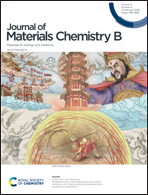Carboxylesterase-activated near-infrared fluorescence probe for highly sensitive imaging of liver tumors†
Abstract
Carboxylesterases (CESs) are critical for metabolizing ester-containing biomolecules and are specifically important in liver metabolic disorders. The modulation of CESs is also an important issue in pharmacology and clinical applications. Herein, we present a near-infrared (NIR) CES fluorescent probe (NCES) based on the protection–deprotection of the hydroxyl group for monitoring CES levels in living systems. The NCES probe has good selectivity and sensitivity for CESs with a limit of detection (LOD) of 5.24 mU mL−1, which allows for tracing the fluctuation of cellular CES after treatment with anticancer drugs and under inflammation and apoptosis states. Furthermore, NCES can be successfully applied for guiding liver cancer surgery with high-contrast in vivo imaging and detecting clinical serum samples from liver cancer patients. This work showed that the NCES probe has great potential in drug development, imaging applications for medical diagnosis, and early-stage detection for clinical liver diseases.



 Please wait while we load your content...
Please wait while we load your content...